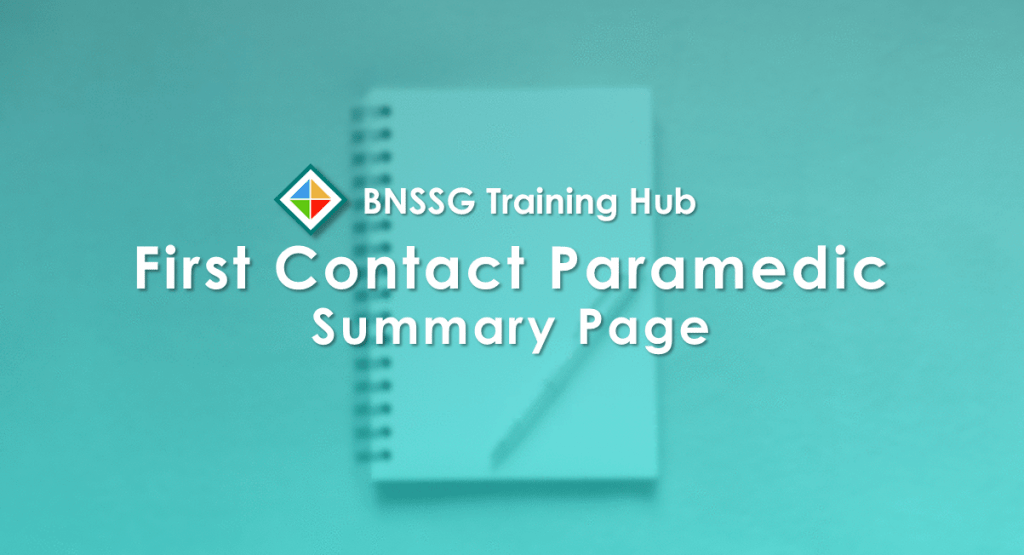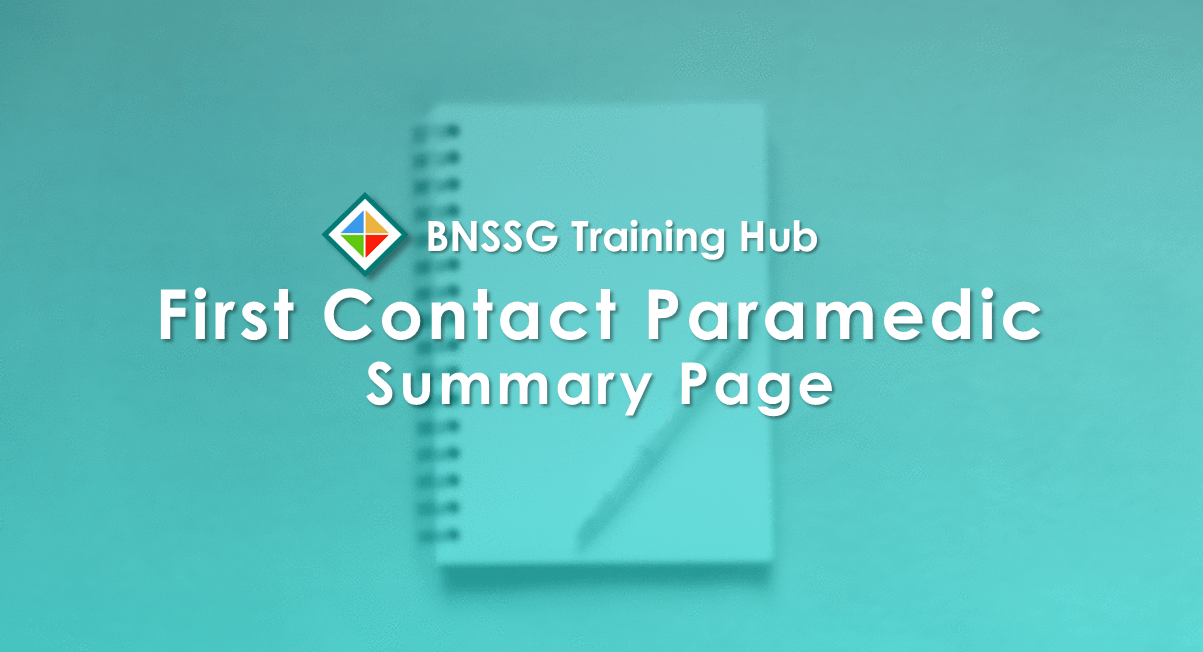What are they?
What benefits can they bring?
What is their scope of practice?
Is funding available for them?
Are there any case studies?
What training, qualifications, and competencies should they have?
What educational pathways are there?
NEW: How does the ARRS link to HEE's Roadmap?
Are they eligible for the apprenticeship levy?
Any example job descriptions?
Any sample interview questions? [DONE]
What clinical supervision do they need?
What ongoing support is available?
NEW: Do you have any resources for the HEE Roadmap portfolio route?
What are first contact paramedics?
First contact paramedics are autonomous, diagnostic clinicians with experience in handling undifferentiated and unpredictable cases; conducting an array of clinical assessment, diagnostic, and treatment activities; and directing and signposting care. They are at the top of their clinical scope of practice at Agenda for Change Band 7 (A Roadmap to Practice, see below).
As generalists, they can effectively use the medical / biopsychosocial model to assess, examine, treat, and manage patients of all ages, with a variety of undifferentiated and chronic conditions. Their work can involve triaging patients, carrying out telephone and face-to-face consultations, and conducting home visits. They refer patients to GPs for the management of presentations and pharmacology outside their scope of practice.
For more information, please read HEE’s A Roadmap to Practice and the College of Paramedics’ Employers’ Guide: Paramedics in Primary and Urgent Care.
A Roadmap to Practice
Produced by HEE, this document provides a roadmap of education for practice, for all first contact paramedics working in primary care.
To read this document, please click here.
Employers' Guide: Paramedics in Primary and Urgent Care
Produced by the College of Paramedics, this document was produced by a multi-professional group and provides concise information regarding the current education and regulatory standards for paramedics.
To download this document, please go to the CoP’s site by clicking here.
What benefits can first contact paramedics bring?
GPs face a constant and increasing demand for their time. First contact paramedics can help to alleviate this by addressing a wide range of undifferentiated presentations to urgent and primary care (including frailty, long-term conditions, and mental health crises). In so doing, they not only enable GPs to turn their attention to more complicated presentations when needed, but paramedics also ensure that patients can receive equitable treatment from a MDT workforce that isn’t so unduly strained. Patients are less likely to need to go to the hospital, as paramedics are well-equipped to see, treat, and / or refer as appropriate by themselves performing home visits.
Please see the Paramedic Specialist Core Capabilities Framework below for more information.
“Paramedics have so many complementary skills and in primary care there are many areas where paramedics can complement the rest of the primary care team, not least acute care, but also, domiciliary visiting and follow up to the same that may well enable patients to stay in their own home rather than be admitted to hospital…“
Professor Simon Gregory
Director of Education and Quality
(HEE, working across Midlands and East)
(Ref. Paramedic Specialist Core Capabilities Framework)
Paramedic Specialist Core Capabilities Framework (2019)
Produced jointly by HEE, Skills for Health, and the College of Paramedics, this framework establishes the scope of practice for paramedics working in primary care.
To read this framework, please click here.
What is the scope of their practice?
First contact paramedics’ scope of practice is outlined in HEE’s A Roadmap to Practice for first contact and advanced paramedics. This document offers a clear educational pathway from undergraduate to advanced practice for paramedics seeking a career in primary care, outlining the skills and attributes required to become a first contact paramedic or advanced paramedic, in addition to establishing the supervision and governance needed to support them.
In asserting the capabilities of first contact and advanced paramedics, this document assists employers and workforce planners in understanding what this role can bring to the table in a multi-professional team, and thereby support the delivery of the best patient care.
For a detailed breakdown of a first contact paramedic’s scope of practice, please consult the Roadmap to Practice and read:
- Section 3.0: National standards and frameworks for MSK practitioners
- Appendix 12.14: Knowledge, Skills and Attributes document
A Roadmap to Practice
Produced by HEE, this document provides a roadmap of education for practice, for all first contact paramedics working in primary care.
To read this document, please click here.
Is funding available for first contact paramedics?
From April 2021 onward, first contact paramedics can be recruited by PCNs through the Additional Roles Reimbursement Scheme (ARRS). This scheme provides funding for additional roles, enabling the creation of bespoke multidisciplinary teams. All PCNs are eligible for reimbursement funds, with the amount available dependent on their weighted population share.
Through ARRS, paramedics can be employed by PCNs and reimbursed at 100% of defined salary, plus defined costs. More information on this can be found in NHS Confederation’s guide, below.
Additionally, like nurses, nursing associates, and other AHPs, paramedics are entitled to £1,000 of CPD funding over 3 years.
Recruiting paramedic practitioners through the Additional Roles Reimbursement Scheme
Produced by NHS Confederation, this document serves as a guide to how the ARRS works, how paramedics can be recruited through it, and how paramedics can support your multidisciplinary practice team.
To read it, please click here.
What training, qualifications, and competencies should a paramedic have?
The College of Paramedics (CoP) states that, from 2021 onward, all paramedics should have a BSc (Hons) to be registered with the Health and Care Professions Council (HCPC). This qualification is acquired over 3 to 5 years of study. Paramedics working in advanced practice should be educated to the level of a Master’s degree, however.
The CoP notes that the requirement for higher education qualifications is relatively new, though, with a number of paramedics in advanced practice not having such. The CoP maintains that paramedics aspiring to transition should be educated in line with these requirements — and it is hoped that employers will assist the paramedics they recruit in meeting these standards.
It is also expected that paramedics will have successfully completed a preceptorship programme (or the equivalent of) prior to working in primary care; this is usually done in the first two years after initial registration, via schemes like the Newly Qualified Paramedic (NQP) programme. Completion of a preceptorship is intended to round out paramedics, with experience in assessing and managing an array of patients across the clinical and social spectrum.
For more information on a first contact paramedic’s required competencies, please refer to the Paramedic Specialist in Primary and Urgent Care Core Capabilities Framework.
For a detailed breakdown on the training required for a paramedic to practice at first contact and advanced levels, please refer to HEE’s Roadmap to Practice below.
Paramedic Specialist Core Capabilities Framework (2019)
Produced jointly by HEE, Skills for Health, and the College of Paramedics, this framework establishes the scope of practice for paramedics working in primary care.
To read this framework, please click here.
A Roadmap to Practice
Produced by HEE, this document provides a roadmap of education for practice, for all first contact paramedics working in primary care.
To read this document, please click here.
Are there any case studies?
HEE are currently producing case studies for first contact paramedics. Please stand by until they’re ready to be released.
Are paramedics eligible for the apprenticeship levy?
The short answer is yes — to access it, a first contact paramedic will need to secure the backing of a GP and their practice manager, before reaching out to the Training Hub. It is then a matter of applying to UWE’s apprenticeship scheme.
For more information, please do contact our ACP Lead, Kerri Magnus, at kerri.magnus2@nhs.net using the button below.
Alternatively, you can download MSc AP Apprenticeship Programme to read more about UWE’s scheme for advanced clinical practitioners.
MSc AP Apprenticeship Programme
This document provides information on UWE’s apprenticeship programme for advanced clinical practitioners.
To read it, please click here.
What academic qualifications should an FCP have?
An FCP should be pursuing one of the following routes to become qualified:
- Completing a BSc Physiotherapy degree at a recognised university
- Completing a BSc Degree Apprenticeship, combining on-the-job training with university-level learning an study
- Completing an integrated Master’s degree — a four-year, full-time course combining undergraduate and postgraduate study into a single course
- Completing a Master of Science degree for those who have studied at undergraduate level in another relevant subject area: (e.g., biological sciences, psychology, or sports science, consisting of a range of lectures, placements, and assessments over 2 years
Generally speaking, an FCP should have 1,000 placement hours under their belt, though this can vary depending on the qualification they’re pursuing.
Detailed information on accredited university courses can be found at this link:
Find a physiotherapy programme | The Chartered Society of Physiotherapy (csp.org.uk)
Any example job descriptions?
Please stand by whilst we confirm HEE’s job description for first contact paramedics.
Any sample interview questions?
We will provide sample interview questions soon. Thank you for your patience.
What clinical supervision do you need to provide?
HEE stipulates that the clinical supervision you provide should build the first contact paramedic’s confidence, capability, clinical reasoning, and critical thinking. As such, it should include:
- Regular supervision within practice
- A routine debrief (at least daily) to ensure patient and practitioner safety
- A high-quality feedback process, to help with addressing practitioner and patient uncertainty
- A Workplace-Based Assessment (WPBA) to assess the application of knowledge, skills, and behaviours in primary care
Our Paramedic Lead, Lily Dixon, has put together a one-page document elaborating on and providing guidance around the portfolio route to practice.
For information on how to become a first contact paramedic’s supervisor, please consult the illustration and relevant documents below.
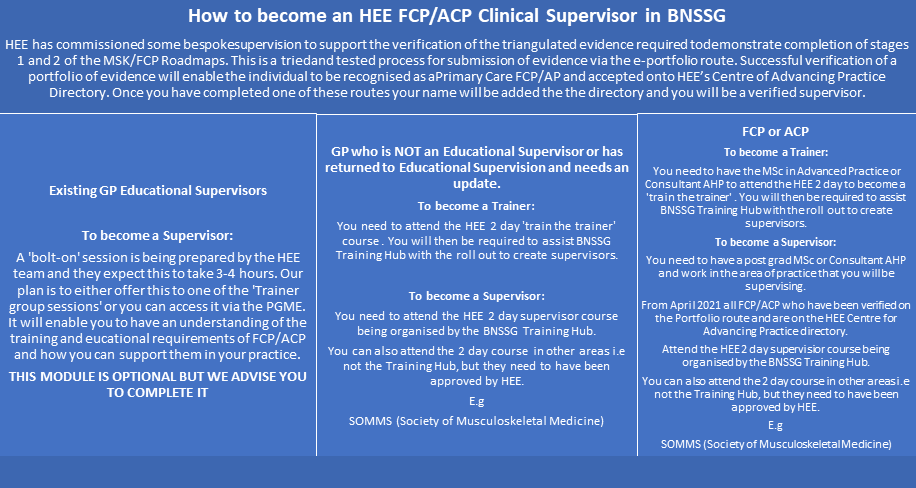
Training Hub FCP - AP Roadmap Supervision Portfolio Guide
Compiled by Lily Dixon, this document provides guidance on the portfolio route to practice for first contact and advanced paramedics.
To read it, please click here.
HEE Clinical Supervision for FCPs / ACPs FAQs
Compiled by Kerri Magnus, this document addresses many frequently asked questions surrounding clinical supervision for first contact practitioners and advanced clinical practitioners (including first contact paramedics).
To read it, please click here.
HEE's FCP / ACP Roadmap Supervision slides
Provided by HEE, this slide deck outlines the supervision process for first contact practitioners and advanced clinical practitioners.
To read it, please click here.
HEE's Workplace Supervision for Advanced Clinical Practice guide
Produced by HEE, this document is intended for employers and supervisors, to support them in delivering high-quality workplace supervision to advanced clinical practitioners in training.
To read it, please click here.
What ongoing support is available?
There are various ways in which first contact paramedics can receive support, including:
1:1 Sessions
Lily Dixon, our Paramedic Lead, is available to run 1:1 sessions for advanced clinical practitioners, in which they can create their own individual pathways, relevant to their role and practice goals. These will be 15-30 minutes, and GPs / Practice Managers are also welcome to book a slot, should they wish to ask any questions relating to first contact practitioners or advanced clinical practitioners.
You can contact Lily at lily.dixon2@nhs.net, by clicking here.
The ACP Forum
Organised and led by our ACP Lead, Kerri Magnus, The ACP Forum can assist first contact paramedics on the journey to becoming an advanced clinical practitioner. The Forum can signpost to relevant education and training, provide 1-to-1 guidance, and facilitate networking with like-minded colleagues from across BNSSG.
To visit The ACP Forum’s site, please click here.
The College of Paramedics (CoP)
The College of Paramedics is a professional body for UK paramedics, well-placed to lead the profession’s development across a variety of health and care settings, informing national and regional legislation and policy. Membership does require a fee but comes with a number of benefits, including free access to The British Paramedic Journal (BPJ) — a quarterly, peer-reviewed electronic journal.
To find out more, please click here.
CoP Diploma in Primary and Urgent Care
The College of Paramedics provides a professional Diploma in Primary and Urgent Care (DIP PUC) examination, which is designed to assess the skills, knowledge, and attitudes of experienced, specialist paramedics. It is intended to incorporate the range of possible patient presentations and depth of knowledge required to carry out an effective, successful patient consultation.
To find out more, please click here.
BNSSG FCP / ACP (Paramedic) Survey
Kerri Magnus has also designed a survey to establish the learning needs of first contact and advanced practitioners, including paramedics. Completing this survey will assist us in directing funding to appropriate higher education modules and CPD. All data acquired will be anonymised in presentations, but ourselves and Avon LMC will keep a summary of individual requirements so that if resources become available (and agreed by practice), we’ll be able to direct funding appropriately.
To access the survey, please click here.
Do you have any resources for the HEE Roadmap portfolio route?
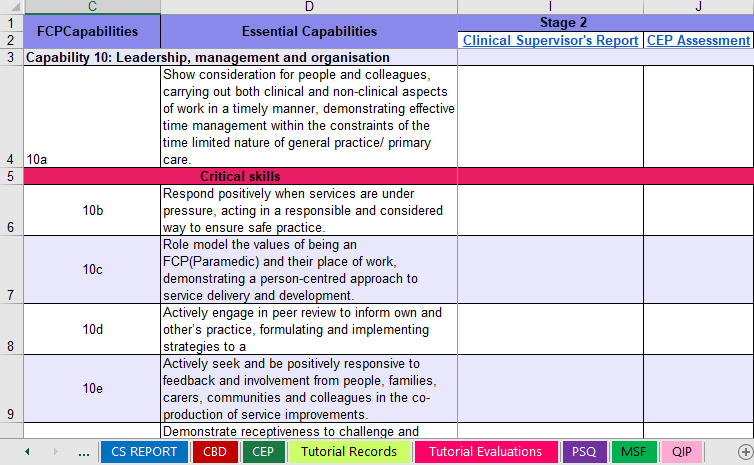
Developed by our Paramedic Lead, Lily Dixon, this template Excel spreadsheet should help to record evidence for your portfolio. Below is the recording for an accompanying webinar, held on Tuesday 14 September.
What educational pathways are there?
At present, there are two main educational pathways by which one can train to be a first contact or advanced paramedic:
- Via an FCP portfolio and taught routes, with onward portfolio route or a taught Advanced Practice master’s to become an Advanced Practitioner
- Via an AP portfolio or taught routes with the addition of the required primary care KSA training
The diagram below provides a visual representation of this routes.
For more information, please see HEE’s Roadmap to Practice using the collapsible box below.
A Roadmap to Practice
Produced by HEE, this document provides a roadmap of education for practice, for all first contact paramedics working in primary care.
To read this document, please click here.
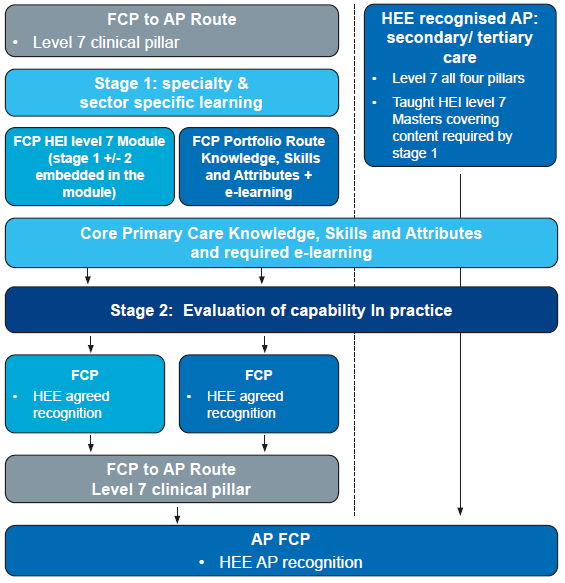
How does the ARRS link to HEE's Roadmap?
First contact physiotherapists employed under the Additional Roles Reimbursement Scheme (ARRS) have a deadline of April 2022 to complete stages 1 & 2 of HEE’s Roadmap to Practice to enable drawing down of funding.
If you are not employed under ARRS, then you do not have this deadline. It is beneficial to complete them, however, if you want to be on the Centre for Advancing Practice Directory — you will need to have gone through stages 1 & 2 before moving on to stage 3 and advanced clinical practice.
Both stages can be completed in general practice and signed off by a verified clinical roadmap supervisor, or you can attend a taught route. You will still need to have evidence of clinical supervision by a roadmap supervisor to ensure competency, though.
For weekly updates here, please refer to HEE’s site using the button below.
Literature
Employers' Guide: Paramedics in Primary and Urgent Care
Produced by the College of Paramedics, this document was produced by a multi-professional group and provides concise information regarding the current education and regulatory standards for paramedics.
To download this document, please go to the CoP’s site by clicking here.
FCP (Paramedic) Resource Pack
A collection of useful documents, pulled together by our Paramedic Profession Lead, Lily Dixon, which includes:
- HEE FCP (Paramedic) Portfolio Template 2.0
- Primary Care Toolkit for PCN Recruitment v2: Paramedic
- Introduction to Primary Care Checklist
- Creating a Patient Satisfaction Questionnaire Guide
- HEE FCP – ACP (Paramedic) Roadmap
- FCP (Paramedic) Portfolio Guide
- Paramedic FCP – AP (Paramedic) Roadmap Supervision Portfolio Route Guide
Released in June 2022.
To download this pack, please click here.
HEE Clinical Supervision for FCPs / ACPs FAQs
Compiled by Kerri Magnus, this document addresses many frequently asked questions surrounding clinical supervision for first contact practitioners and advanced clinical practitioners (including first contact physiotherapists).
To read it, please click here.
HEE's A Roadmap to Practice
Produced by HEE, this document provides a roadmap of education for practice, for all first contact paramedics working in primary care.
To read this document, please click here.
HEE's FCP / ACP Roadmap Supervision slides
Provided by HEE, this slide deck outlines the supervision process for first contact practitioners and advanced clinical practitioners.
To read it, please click here.
HEE FCP (Paramedic) Portfolio Template 2.0
Produced by our Paramedic Lead, Lily Dixon, this template Excel spreadsheet should help to record evidence for your portfolio.
Released in June 2022.
To read it, please click here.
HEE's Workplace Supervision for Advanced Clinical Practice guide
Produced by HEE, this document is intended for employers and supervisors, to support them in delivering high-quality workplace supervision to advanced clinical practitioners in training.
To read it, please click here.
MSc AP Apprenticeship Programme
This document provides information on UWE’s apprenticeship programme for advanced clinical practitioners.
To read it, please click here.
Paramedic Specialist Core Capabilities Framework (2019)
Produced jointly by HEE, Skills for Health, and the College of Paramedics, this framework establishes the scope of practice for paramedics working in primary care.
To read this framework, please click here.
Recruiting paramedic practitioners through the Additional Roles Reimbursement Scheme
Produced by NHS Confederation, this document serves as a guide to how the ARRS works, how paramedics can be recruited through it, and how paramedics can support your multidisciplinary practice team.
To read it, please click here.
A/V resources
An Essential Update about First Contact Practitioners and Advanced Clinical Practice in primary care
Arranged by Somerset LMC and Somerset Training Hub, this 1.5 hour webinar provides a concise, ideal look at the scope and requirements of first contact / advanced clinical practitioners (FCPs / ACPs), and at how best to provide the support, supervision, and conditions they need to thrive.
A range of individuals contributed, including our own ACP Lead, Kerri Magnus.
For more information, and to watch this webinar, please click here (do note that you will need to register).
[This webinar was held on 04/02/21]
HEE FCP Roadmap Webinar
On Wednesday 24 March, HEE held a webinar on their first contact practitioner (FCP) Roadmaps to Practice. This webinar will be of interest to those in MSK and paramedic roles and will specifically cover the portfolio route through, with guidance and insights into how delegates can look to build their portfolios.
The recording is now available to watch and download.
To access the recording, please click here. To download the slides, please click here.
[This video was published on 01/04/21]
NEW: HEE FCP (Paramedic) Roadmap Stage 1 Webinar
On Tuesday 14 September, we ran a webinar on the HEE FCP (Paramedic) Roadmap to Practice. In it, our Paramedic Lead, Lily Dixon, guided delegates through her take on and response to the portfolio route.
The recording is now available to watch. The accompanying template spreadsheet can be found under Literature.
To access the recording, please click here.
[This video was published on 17.09.21]

